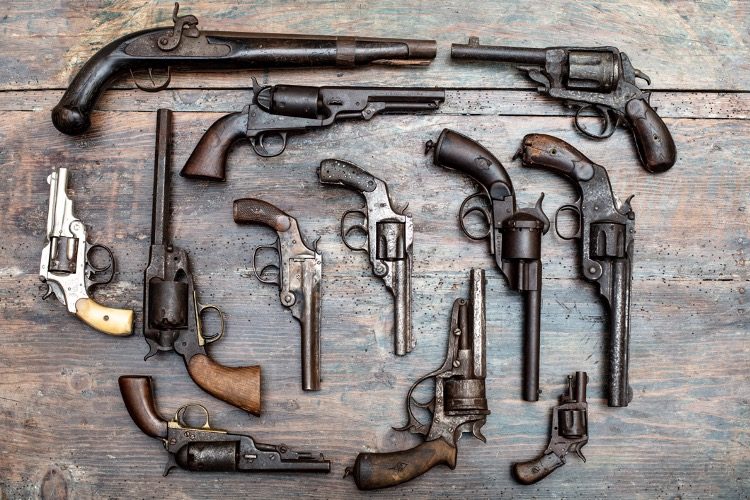
About a quarter century ago, there was a feel-good story about Colorado schoolchildren who’d raised approximately $35,000 to “buy the freedom” of 601 Sudanese slaves. The intentions were surely good. Yet even if those slaves actually were freed, what was to stop the African slavers from seizing more slaves to replenish their stock, seeing the market that exists for them? So the effort, it would seem, was symbolism over substance.
Is it the same with gun “buyback” programs? None other than the liberal Atlantic answers yes.
The Atlantic writer, David A. Graham, presents a representative autumn “buyback” program event in Durham County, North Carolina, where those turning in firearms could receive $100 for a long gun, $150 for a handgun, and $200 for an AR-15-category rifle. As Graham writes:
Many of the specimens were unremarkable, such as a procession of aging shotguns, but a few elicited murmurs of amazement. A slew of six-shooters drew laughs. “Wild Wild West!” one deputy exclaimed, cackling. Another shook his head: “Last time I saw someone carrying that was Clint Eastwood.” One turn-in appeared to be a World War II–era U.S. Army service pistol. Another was an old SKS with Chinese characters stamped on the barrel. But the consensus star of the day was an old Swiss rifle of indeterminate caliber, with a manufacturer’s mark indicating that it had been made in January 1877.
All told, 149 firearms were collected. They were then to be traced for connection to crimes and, if they came up clean, retained for three to sixth months before being destroyed, with a judge’s permission. (Note: Destroying antiques that may belong in a museum could seem somewhat Taliban-ish.)
This may appear a waste of time. But, it turns out, the 1877 rifle was connected with an unsolved 1882 murder in Dodge City, Kansas. Authorities are now redoubling their efforts to apprehend the perp.
(Yes, that was CNN-like news — a joke.)
Graham points out that the above event was Durham County’s third “buyback” since 2022 and that these programs have become common countrywide. They’re popular because in a time in which there’s great pressure to “do something about guns,” “buybacks” are efforts that both Left and Right can endorse. They don’t imperil anyone’s gun rights but, nonetheless, liberals (and other rationalizers) can feel good about “getting guns off the streets.”
Launching one of these programs “often feels better than just sitting on the sidelines, worrying and complaining,” Duke University professor emeritus and “gun expert” Phil Cook told Graham.
(Note that “buyback(s)” is in quotation marks because it’s a misnomer: Nothing is bought “back” because the state never owned the guns in the first place. Of course, someone who fancies that everything inherently belongs to the government may disagree.)
So what’s the problem with these programs? It’s not that, as MSN commenter E.C. Gibbs put it, “I did a background check and found the government an unfit candidate for me to sell them a firearm. I couldn’t in good conscience do such a thing.” Though, many would sympathize with his position. Rather, it is this:
“They don’t work,” writes Graham.
“Scholars have tried for years to quantify the benefit of buybacks, and they’ve consistently found little empirical evidence that they do much of anything to reduce gun violence at all,” he continues.
Don’t tell Durham County sheriff Clarence Birkhead this, though. He told Graham that “to me, it’s making our community safe by guaranteeing that these weapons would not end up on the street.”
Yet this claim defies common sense. As Graham tells us, the
antique arsenal at the Durham event demonstrates one of the recurring flaws of buyback efforts: You mostly get guns that wouldn’t be used in crimes anyways. Most gun crimes in the U.S. are committed with handguns, but few modern, operable ones get turned in. Although AR-15s are a flash point in the gun-control debate because they are used in many of the worst mass shootings, they are far, far less common than handguns…. Most of the weapons turned in … were either shotguns or elderly pistols.
Obviously, a criminal requiring an expensive gun to ply his dark trade is not going to turn it in for a relative pittance. And with approximately 400 million firearms circulating in the United States, collecting some retired rods is not going to reduce availability.
One bright spot is that at least Durham County isn’t funding this fool’s errand with taxes. Instead, the government “uses money seized in law-enforcement operations,” Graham informs, before adding, “That said, asset forfeiture is itself a fraught practice.” Of course, it’s possible that other jurisdictions do use tax money for the “buybacks.”
There are other issues, too. “Buyback” programs don’t accept “so-called ghost guns, which are built from kits or 3-D-printed and don’t have serial numbers,” relates Graham, “because officials don’t want to encourage anyone to produce guns just to pocket rewards.” What’s more, many weapons “surrendered in buybacks were sent to companies that promised to destroy them but actually resold a substantial amount,” Graham later added.
Then there’s something unmentioned. Graham states that while surrendered firearms are supposed to be in working order, Durham County doesn’t, and can’t realistically, test them to ensure functionality. So what’s to stop an aspiring criminal from turning in a malfunctioning gun that cannot be traced to a crime, and putting the proceeds toward the purchase of an effective weapon?
Whatever the case, at least Sheriff Birkhead feels as if the “buyback” is making the “community safe.” Hey, it’s just like Linus’s security blanket.



